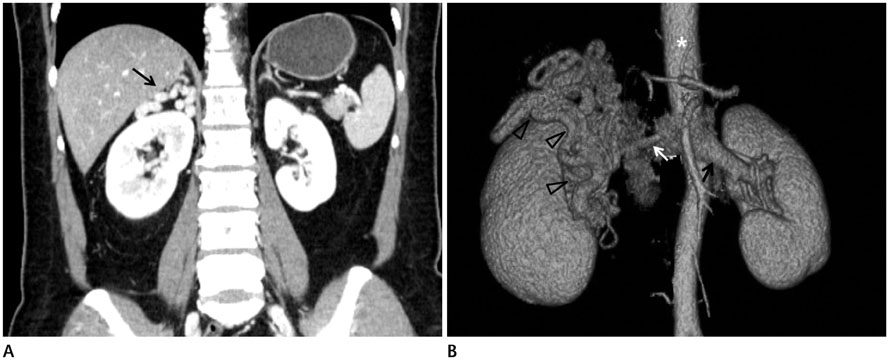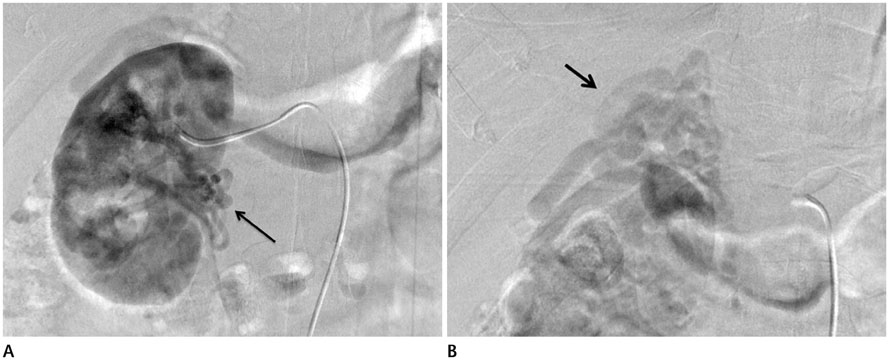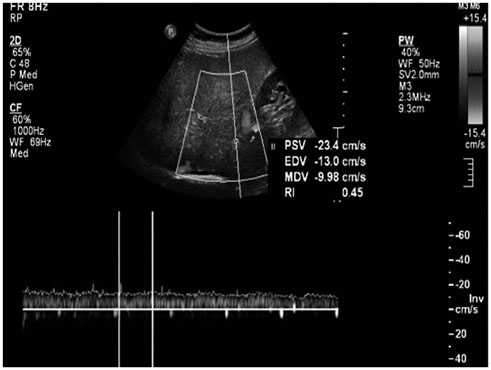J Korean Soc Radiol.
2015 Jun;72(6):427-430. 10.3348/jksr.2015.72.6.427.
Absence of Orthotopic Renal Vein with Aberrant Suprarenal Venous Drainage: A Case Report
- Affiliations
-
- 1Department of Radiology, Inha University Hospital, Incheon, Korea. radjeon@inha.ac.kr
- 2Department of General Surgery, Inha University Hospital, Incheon, Korea.
- 3Department of Urology, Inha University Hospital, Incheon, Korea.
- KMID: 2098024
- DOI: http://doi.org/10.3348/jksr.2015.72.6.427
Abstract
- A CT scan of a 49-year-old female incidentally revealed a tortuous vascular structure in the right suprarenal space. According to angiographic evaluation of the right renal vessels, the right renal artery was single with normal diameter, and there was no venous drainage through the main right renal vein (orthotopic renal vein). The venous drainage of the right kidney flowed through the tortuous suprarenal vascular structure into the inferior vena cava. The color Doppler ultrasound revealed the monophasic waveform in that vascular structure without flow disturbance. The renal function and the result of urinalysis of the patient were normal, and any other congenital malformation was not found. Absence of the orthotopic renal vein and aberrant suprarenal venous drainage is a very rare congenital anomaly, and it should be discriminated from the other pathologic conditions.
MeSH Terms
Figure
Reference
-
1. Mathews R, Smith PA, Fishman EK, Marshall FF. Anomalies of the inferior vena cava and renal veins: embryologic and surgical considerations. Urology. 1999; 53:873–880.2. Satyapal KS. The renal veins: a review. Eur J Anat. 2003; 7:43–52.3. Bozlar U, Ugurel MS, Bedir S, Ors F, Coskun U, Aydur E. Right renal vein aplasia associated with diverted renal venous drainage through lower pole. Cardiovasc Intervent Radiol. 2008; 31:Suppl 2. S140–S143.4. Pinggera GM, Spranger R, Frauscher F, Eder R, Smekal A, Bartsch G. Congenital absence of the right renal vein. J Urol. 2003; 170:914–915.5. Satyapal KS. Classification of the drainage patterns of the renal veins. J Anat. 1995; 186(Pt 2):329–333.6. James EC, Fedde CW, Khuri NT, Gillespie JT. Division of the left renal vein: a safe surgical adjunct. Surgery. 1978; 83:151–154.7. Witz M, Korzets Z. Renal vein occlusion: diagnosis and treatment. Isr Med Assoc J. 2007; 9:402–405.8. Diniz GV, Pereira WJ, Moreira AC, Santos BM, Drumond DA, Petroianu A. Kidney function after left renal vein ligation in the dog. Rev Hosp Clin Fac Med Sao Paulo. 2001; 56:1–4.
- Full Text Links
- Actions
-
Cited
- CITED
-
- Close
- Share
- Similar articles
-
- Prevalence and clinical relevance of the anatomical variations of suprarenal arteries: a review
- Abnormal ramification pattern of the renal and testicular vessels
- Persisting subcardinal vein associated with unilateral ectopic pelvic kidney
- Absence of retromandibular vein associated with atypical formation of external jugular vein in the parotid region
- Levoatriocardinal Vein Combined with Pulmonary Venous Varix Mimicking Arteriovenous Malformations: A Case Report




